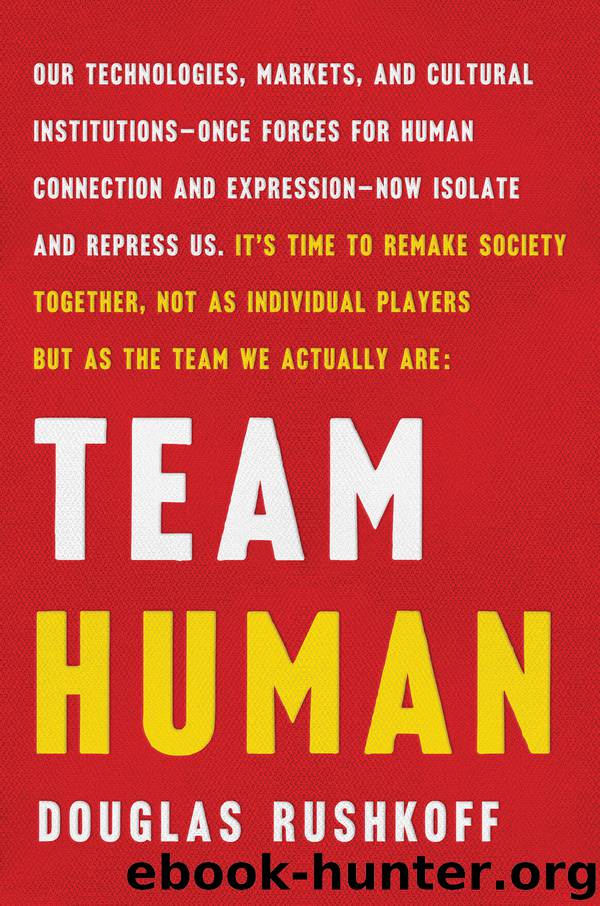Team Human by Douglas Rushkoff

Author:Douglas Rushkoff
Language: eng
Format: epub
Tags: Epub3
Publisher: W. W. Norton & Company
FROM PARADOX TO AWE
59.
You know that moment when a dog sees something it doesn’t quite understand? When it tilts its head a little bit to one side, as if viewing the perplexing phenomenon from another angle will help? That state of confusion, that huh?, may be a problem for the dog, but it’s awfully cute to us. That’s because for humans, a state of momentary confusion offers not just frustration but an opening.
Team Human has the ability to tolerate and even embrace ambiguity. The stuff that makes our thinking and behavior messy, confusing, or anomalous is both our greatest strength and our greatest defense against the deadening certainty of machine logic.
Yes, we’re living in a digital age, where definitive answers are ready at the click. Every question seems to be one web search away. But we are mistaken to emulate the certainty of our computers. They are definitive because they have to be. Their job is to resolve questions, turn inputs into outputs, choose between 1 or 0. Even at extraordinary resolutions, the computer must decide if a pixel is here or there, if a color is this blue or that blue, if a note is this frequency or that one. There is no in-between state. No ambiguity is permitted.
But it’s precisely this ambiguity—and the ability to embrace it—that characterizes the collectively felt human experience. Does God exist? Do we have an innate purpose? Is love real? These are not simple yes-or-no questions. They’re yes-and-no ones: Mobius strips or Zen koans that can only be engaged from multiple perspectives and sensibilities. We have two brain hemispheres, after all. It takes both to create the multidimensional conceptual picture we think of as reality.
Besides, the brain doesn’t capture and store information like a computer does. It’s not a hard drive. There’s no one-to-one correspondence between things we’ve experienced and data points in the brain. Perception is not receptive, but active. That’s why we can have experiences and memories of things that didn’t “really” happen. Our eyes take in 2D fragments and the brain renders them as 3D images. Furthermore, we take abstract concepts and assemble them into a perceived thing or situation. We don’t see “fire truck” so much as gather related details and then manufacture a fire truck. And if we’re focusing on the fire truck, we may not even notice the gorilla driving it.
Our ability to be conscious—to have that sense of what-is-it-like-to-see-something—depends on our awareness of our participation in perception. We feel ourselves putting it all together. And it’s the open-ended aspects of our experience that keep us conscious of our participation in interpreting them. Those confusing moments provide us with opportunities to experience our complicity in reality creation.
It’s also what allows us to do all those things that computers have been unable to learn: how to contend with paradox, engage with irony, or even interpret a joke. Doing any of this depends on what neuroscientists call relevance theory. We don’t think and communicate in whole pieces, but infer things based on context.
Download
This site does not store any files on its server. We only index and link to content provided by other sites. Please contact the content providers to delete copyright contents if any and email us, we'll remove relevant links or contents immediately.
| Anthropology | Archaeology |
| Philosophy | Politics & Government |
| Social Sciences | Sociology |
| Women's Studies |
Cecilia; Or, Memoirs of an Heiress — Volume 1 by Fanny Burney(32495)
Cecilia; Or, Memoirs of an Heiress — Volume 2 by Fanny Burney(31909)
Cecilia; Or, Memoirs of an Heiress — Volume 3 by Fanny Burney(31888)
The Great Music City by Andrea Baker(31756)
We're Going to Need More Wine by Gabrielle Union(19003)
All the Missing Girls by Megan Miranda(15770)
Pimp by Iceberg Slim(14433)
Bombshells: Glamour Girls of a Lifetime by Sullivan Steve(14020)
For the Love of Europe by Rick Steves(13531)
Talking to Strangers by Malcolm Gladwell(13288)
Norse Mythology by Gaiman Neil(13274)
Fifty Shades Freed by E L James(13185)
Mindhunter: Inside the FBI's Elite Serial Crime Unit by John E. Douglas & Mark Olshaker(9260)
Crazy Rich Asians by Kevin Kwan(9217)
The Lost Art of Listening by Michael P. Nichols(7452)
Enlightenment Now: The Case for Reason, Science, Humanism, and Progress by Steven Pinker(7272)
The Four Agreements by Don Miguel Ruiz(6697)
Bad Blood by John Carreyrou(6581)
Weapons of Math Destruction by Cathy O'Neil(6213)
